|
Lie of the
Land: Notes on The
Subversive Landscape
Martin Holman
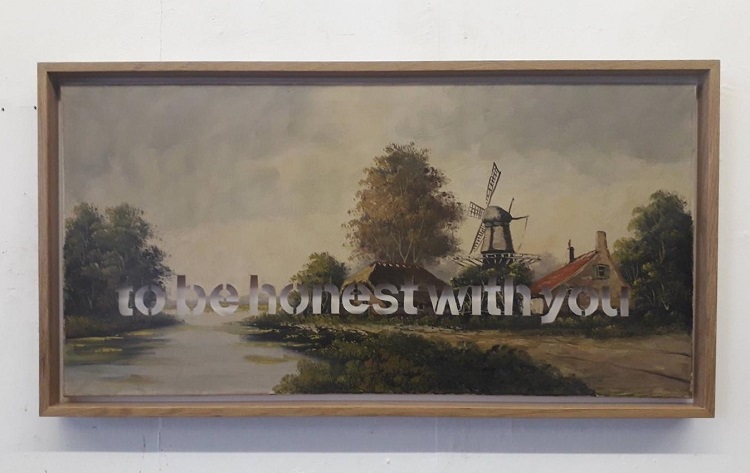
Amikam Toren, Armchair Painting
- Untitled (To Be Honest With You), 2003-4, oil paint on canvas, 500 x
900 mm
According to government
statistics published last October, 8.7 percent of land in England is
developed. ‘Developed land’ means anything from agriculture, the biggest
user, through industrial and residential uses, to defence, which has the
smallest slice. As a result, over nine-tenths of England is
non-developed land that (to keep matters manageable for the layman)
could be called ‘landscape’. Bring into the mix the national parks and
Areas of Outstanding Natural Beauty (AONBs), and 24 percent of England
ends up within one of these special districts.
Not surprisingly, the English have a particular attachment to landscape
as bracing open space as well as poetic spectacle. A common image of the
land exists in many people’s minds (especially the town-dweller’s) that
has been absorbed from the arts and become a kind of descriptive
shorthand. Asked to summarise landscape, an English respondent might
mention the music of Ralph Vaughan Williams, poetry by William
Wordsworth or the paintings of John Constable. Two and more centuries
later, those visions still set the popular standard.
In a way, that perspective helps explain why British national parks,
unlike their counterparts in the US, exist first and foremost to
preserve ‘natural beauty’. The 1949 Act that set up the parks places
aesthetics over recreation and the environment in importance. As if to
ensure that politicians keep the faith, the National Trust is the second
largest membership organisation in the UK (even though its scope
excludes Scotland). There are more National Trust members in this
country than there are trades unionists.
The 21 artists that
painter Hugh Mendes approached to participate in this show are not
primarily associated with the genre of landscape. Most began their
careers when a questioning attitude to the mechanics of art-making and
to its outcomes were standard procedure. By that time, the traditional
genres defined in the seventeenth century (history, portrait, religious
imagery, everyday life and landscape) had long been dispensed with by
progressive artists imbued with the Modernist spirit.
This background is reflected in ‘The Subversive Landscape’, where the
image is, by and large, a vehicle for concerns unconnected with
depictions of nature. While the choice of image is not incidental to all
these artists (Andrew Grassie, Kirsty Harris, Reece Jones, Liane Lang,
Robin Mason and Alex Gene Morrison can all claim to have responded
specifically to the experience of place or phenomena of the outdoors),
their approaches are predicated upon ideas that are not dependent on
representing open air subjects, nor are they distinguished by questions
of style. Concept is all.
Even John Constable in his day was regarded as radical by his peers. He
rebelled against the orthodox view of a painted landscape as a classical
ideal of balanced arrangements and compositional conceits.
In a sense, he interrogated the image as it was known around 1800.
Constable, who had grown
up in Suffolk, subverted the convention and captured the radiance of a
summer day; light fell in his pictures where it did in nature. Painters,
therefore, have form when it comes to seeing differently what others are
used to seeing.
Rob and Nick Carter, indeed, update Jacob van Ruisdael for the present
century when the digital movie screen has supplanted the static canvas
as the surface on which we encounter images. If Dutch
seventeenth-century art was about sustained observation, then careful
looking is what this husband-and-wife team’s animated version of a
drawing from 1648-50 of a landscape with windmills. In the course of the
24-hour loop, leaves flutter gently and clouds float by – or seem to –
and the inevitable temptation of making the windmills’ sails rotate has
been succumbed to. A drawn or painted image is, by its nature,
artificial: illusion is a visual trick artists use to imitate reality.
With super new tools to fire the imagination, is virtual technology
taking us even further away from the original sensory experience of
nature itself? And what does the Carters’ manoeuvre say about authorship
when the image they depict and manipulate has not existed in that form
for nearly 400 years and was anyway seen not by them but by an observer
they never met or could ever know.
A similar paradox
interests Dan Hays. His landscape, Monkey Island (2014), comes not from
setting up easel and canvas in a rural location. Instead, he remains
indoors and pulls a low-quality image off the internet. He has no
personal association with the location and its atmosphere, nor does the
piece emit or arouse emotion. The scene is a convenient image, the means
rather than the end. Because Hays paints the shimmering pixels, the
building blocks of coded information, and rebuilds the original picture
in the tactile brush marks of the ancient handmade technology of
painting. That passage from screen to canvas highlights a dichotomy
between contrasting methods and experiences. Between analogue and
digital, what is gained and lost?
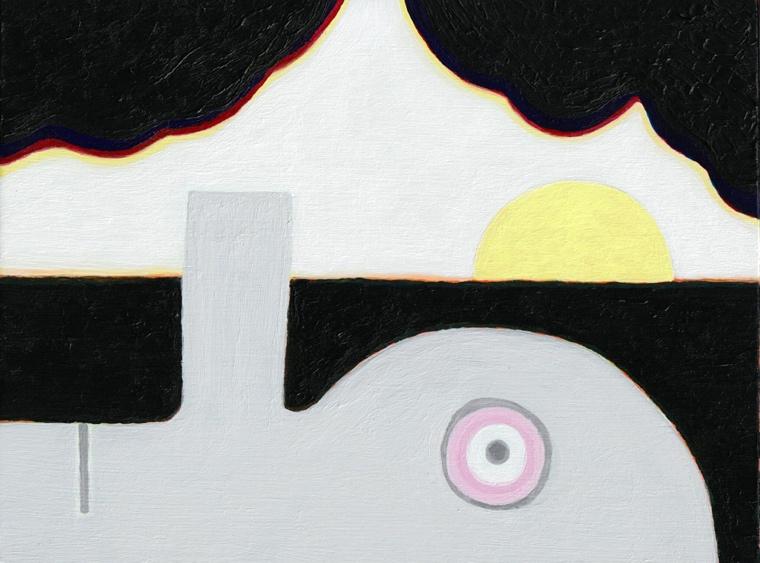
Alex Gene Morrison, Yellow Sun, 2023, acrylic on panel,
150 x 200 mm
The terrain that Redruth-born Canadian artist Alex Gene Morrison depicts
returns landscape to a solid and comforting ideal. Curvy forms that
could correspond with land or a train, or whatever, pass under the sun
in storybook yellow beside pastry-cut silhouettes that might be clouds
or smoke puffing out of stout chimney. Morrison’s vision recedes into a
Telly Tubbies setting, oblong-framed like the TV screen or a maquette
for the wallpaper design of a child’s suburban bedroom. Do we have
slightly infantile expectations of landscape as havens of beauty and
safety rather as sites of change for the sake of utility?
Morrison’s cosy style masks persistent probing while Michael Landy asks
us to examine about our notion of beauty. Weeds are regarded as ‘nature
in the wrong place’ and are plucked as nuisances from paths and grass
verges. Except, that is, by Landy who collected, potted and tended
examples in his studio before making delicate, life-sized studies of
their leaves, stems and roots. With St Francis-like dedication to
emphasise their worth, he calls these marginalised and mongrel growths
‘street flowers’, investing with value what others prefer to control and
eradicate.
Amikam Toren is fascinated by how art solidifies that allegory of
nature’s perfection. For several years he has made what he calls his
‘Armchair Paintings’. The raw material is the type of countryside
imagery we might have in our home that is good to look at, induces calm
and a makes us think of landscape as a retreat from the busy world.
Rather like Hays, Toren finds these pictures readymade – in his case in
charity shops, available to recycle from somebody else’s homes. Then he
cuts out of the surface a phrase like ‘to be honest with you’. The
result is a jolt to our daydreams. What has he to be honest about?
Indeed, sometimes the phrases he imports are offensive, like an argument
overheard in the street, borrowed language that punctures the illusion
and disrupts our leisure.
Words also intrude on Roger Thorpe’s immersive landscape as if to
project a fuller picture. Images slowly emerge on film before
evaporating as if to suggest the finite nature of things. Words appear
in shadowy form on screen (relating to land fought over in war) and
enter the viewer’s space through the soundtrack which recites the war
poetry of Wilfred Owen. ‘But nothing happens,’ the voice repeats when,
ironically, the poem implies that something irrevocable does.
Fiona Banner’s paintings infer a full stop of a different type. Her
route to a conceptual outcome also takes her in pursuit of thrift-shop
canvases – with ships at sea her preferred backdrop to an act of
modification. The ship is enclosed with an odd black shape, which
observers of this artist’s career know to interpret as a hugely
oversized punctuation mark. But not a deash or comma that facilitates
meaning in a phrase but one that actively blocks comprehension and
hampers communication with the viewer who is left, well, all at sea.
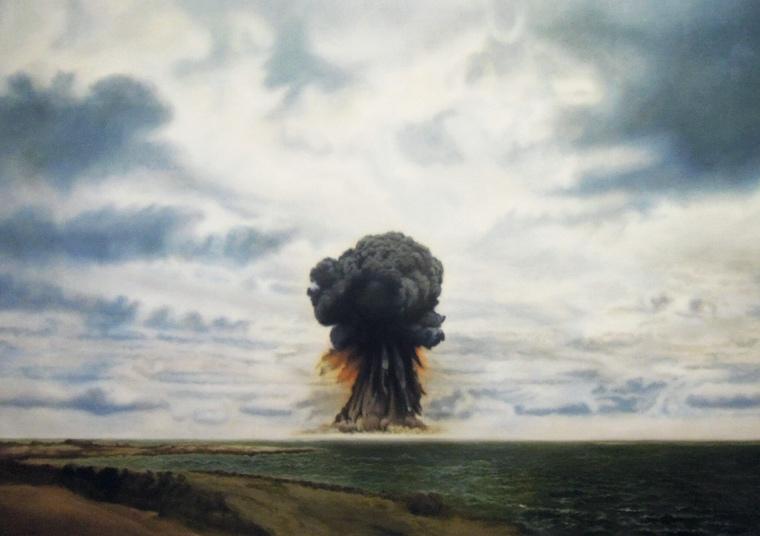
Kirsty Harris, Hardtack Juniper, 2021, oil on unstretched
linen, 2540 x 1650mm
Parody is a tool that asks some serious questions with a light touch.
Rising above the ground in Kirsty Harris’s unstretched oil paintings,
for instance, is the caustic beauty of the mushroom cloud that follows
the rapid release of energy from a high-speed nuclear reaction.
Observers have described the sight as sublime in spite of knowing that
this wholly natural physical phenomenon is engineered by man to cause
cataclysmic, future-changing destruction. Her images are also
appropriated from existing sources, in this case documentation of the
last nuclear detonation on the Bikini Atoll in 1958. Hirst calibrates
the dimensions of her landscape to the quantity of TNT used in each
detonation she re-presents.
Superior forces are implied by Gordon Cheung’s broad vistas and, as in
the real world, they exercise their control from the background. Cheung
depicts a mountain range and expansive sky in heightened colours that
float over a darker prospect, a major infrastructural development
unfolding across the width of his image. He works in a style reminiscent
of Chinese painting and what he shows brings to mind the immense growth
of urban conurbations in China in recent decades as the country’s
economy has expanded rapidly. So, the underlying structure is telling:
Cheung paints over a layer of pink newsprint on which the market pages
of the Financial Times are published. The tight column layout of global
share data seems to give rise to the grid of streets in Cheung’s
megacity.
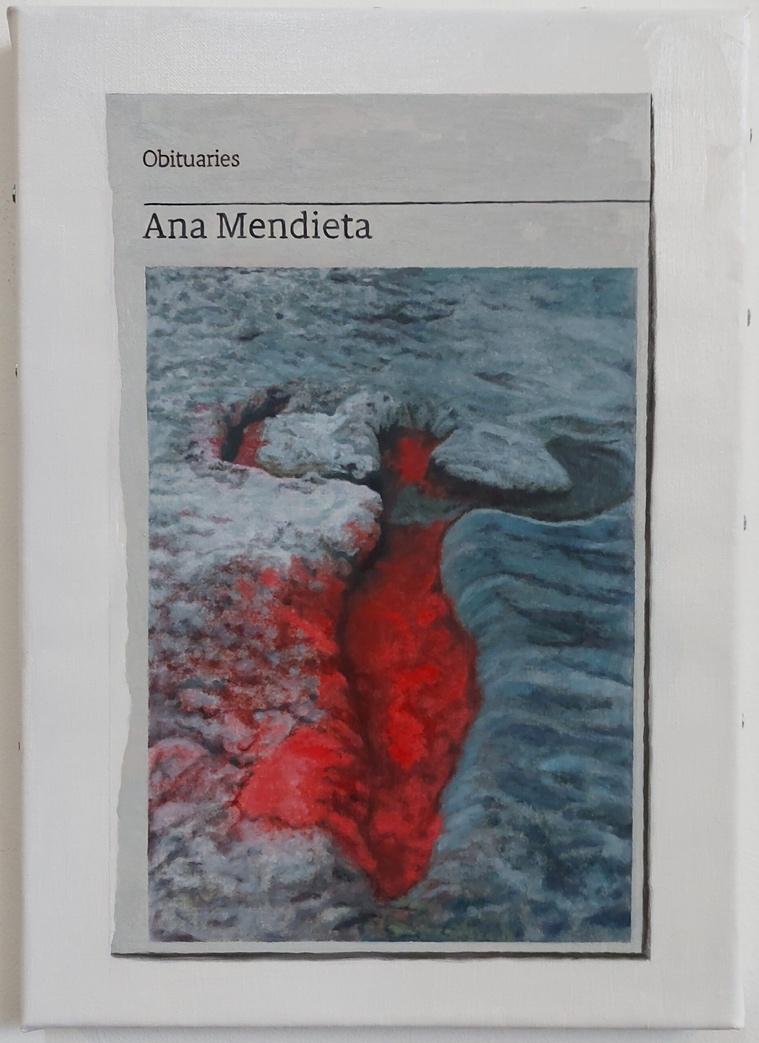
Hugh Mendes, Obituary: Ana
Mendieta, oil on linen, 350 x 250 mm
The land has different meanings for different people. For several years
Hugh Mendes has channelled the visual memorial of dead artists through
the serial format of the obituary page of the Guardian newspaper. The
layout becomes an objective portal to the subjects and their artistic
style. Two examples are Americans Ana Mendieta and Nancy Holt whose work
incorporated spiritual and personal perspectives on the land. So,
landscape occurs in these images, literally drawn from
photo-documentation of well-known examples of each artist’s work. They
could be said to represent those artists as ‘signature’ pieces and,
thus, ‘portraits’ of sorts. Holt saw systems that connected man and
nature through the sun, a belief similar to that of Cornwall’s ancient
inhabitants who constructed stone circles. Mendieta, a Cuban exile,
invoked the symbiosis between place and body found in indigenous
American religions. Seasonal renewal was expressed as a female force in
her performances, drawings and installations.
For Liane Lang the land constitutes a monument to earlier generations
who worked at extracting its resources. Traces remain in the ground
decades after work ceased as the only physical evidence of that labour.
Lang looks for them in redundant mines and quarries because these
unearthed objects are markers of past time. So, she refashions scraps of
machinery into odd curios; modern-day counterparts of medieval
reliquaries, they contain an image of time itself instead of bones.
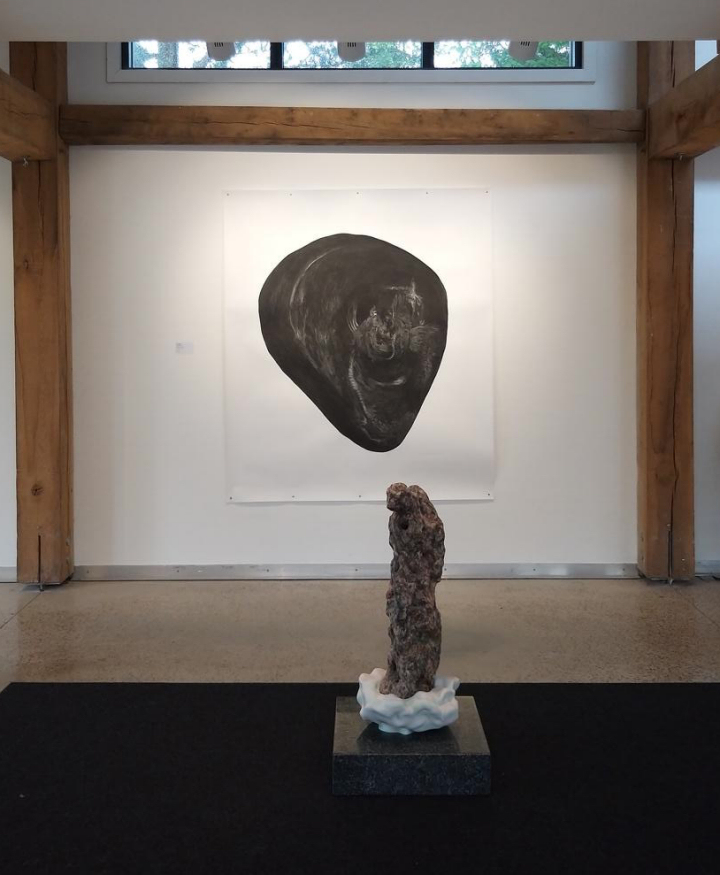
(Background) Lucy Willow, Threshold, charcoal on paper,
1650 x 1500 mm, with (foreground) work by Gordon Cheung
Lucy Willow graduates from considering the visible to imagining the
unseen landscape, albeit one she was physically in the vicinity of. When
she looked into an ancient well she discovered obscured from view by
roots in Lamorna, she could not see beyond the entrance. But the black
void beyond was explored with ultrasound from which a sonar picture
emerged. An artist who researches grief in her work, Willow saw
parallels in this experience with legends of the underworld and the
deep, dark tunnel that bereavement burrows into the emotions of
mourners.
A comparable stillness and mystery surrounds Andrew Grassie’s
above-ground images. The diffused grey light and subtle blush of pink on
the surface, achieved with meticulous technique, are as disorienting as
a heavy mist, capturing a moment in time that might have been real or
was merely remembered, or even first seen in a photograph because it
feels timeless now. The dense charcoal treatment in Reece Jones’s
monochrome work is also unnerving, throwing natural scenery into
silhouette. The black monolith that appears centre-stage in his Drone
series images projects unease because its source is unexplained. The
towering black machines of Arthur C. Clarke’s Space Odyssey series come
to mind, the creations of unseen extraterrestrial presences. Yet, at the
same time, Jones seems to play with the viewer’s known experience of
night-time visions when all the coordinates of daylight disappear and
even the familiar can appear sinister.
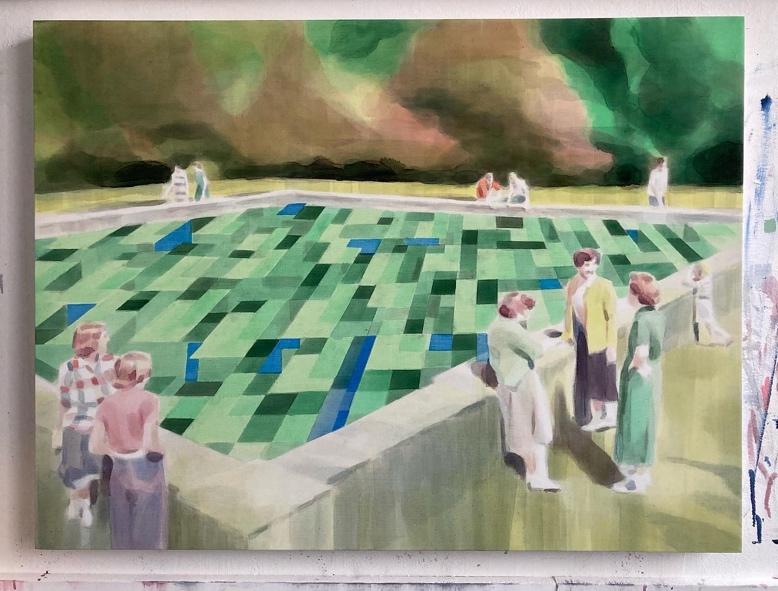
Adam Dix, What Lies Between, 2022, oil glaze on panel,
800 x 600 mm
A science fiction dimension is detectable in Adam Dix’s outdoor scene of
people gathered around a pool-like enclosure. While small groups have
formed on its perimeter to talk, no alarm appears to cross their faces
at the curious pixelation that has befallen their surroundings. With its
washed-out colour, the image resembles an uneven exercise in data
transmission. Indeed, time might have undergone a strange curvature when
communicating this scene to today’s recipients, combining figures
dressed in 50s fashion with a digital phenomenon belonging to a time
decades in their future. Is this an imagined reality or a re-run of a
’fifties television show?
Lee Maelzer’s vision of a location composed of fragments and tangled
threads might be post-apocalyptic. She delves into an environment that
has been destroyed, abandoned or neglected so that we wonder what has
occurred to leave it looking this way. Closer to home, maybe as close as
our own backyards, is the scene photographed by painter Jesse Leroy
Smith of discarded bottles littering the foreground of a view to
mountains. The image is neutral but the inferences are weighted. The
unique capacity of humans among the earth’s creatures to mess up the
natural order with their waste is one interpretation. There will be
others, but in this case – as in that of Kirsty Harris’s painting –
human behaviour is subverting the landscape rather than the artist. He
is there to observe it.
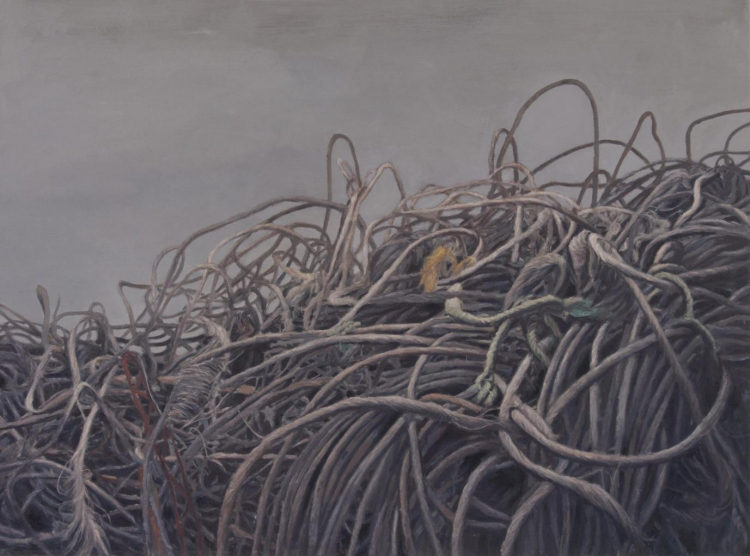
Lee Maelzer, Metal, 2014, oil and oil pastel on canvas,
1965 x 1455 mm
Brought to the foreground
in Metal (2014), Maelzer’s complex chicane of work, is the act of
painting. sparked by the task of depicting her individual choice of
subject-matter in pigment and mark. The same impulse seems present in
Kiera Bennett’s evocation of the land that we approach through painting
itself. The sensory qualities rather than figurative elements are
uppermost to the extent that Bennett does not deal with location.
Instead, the idea of landscape tips into abstraction with boldly brushed
linear arrangements that carry colour, mood and energy. The impression
of landscape remains, rather in the way Cézanne responded to it.
The show succeeds in ushering the viewer into a range of provocative and
thoughtful propositions. There are few mishits in pursuit of its theme,
and when they occur, more digging reveals a reason to be here. The
processes of reduction and remaking at work in the Cornwall-based
Alistair and Fleur Mackie’s enigmatic Complex System 27 and 28 (2016) at
first appear coolly abstract, then suggest being part of a larger whole
as if a bigger story ensues – like a cog might stand for the wheel it
belongs to. Information seems encoded here, too, waiting for the mental
key to unlock a succession of connections. As in reality, the
relationship between material and form, origin and meaning is masked and
hard to decipher.
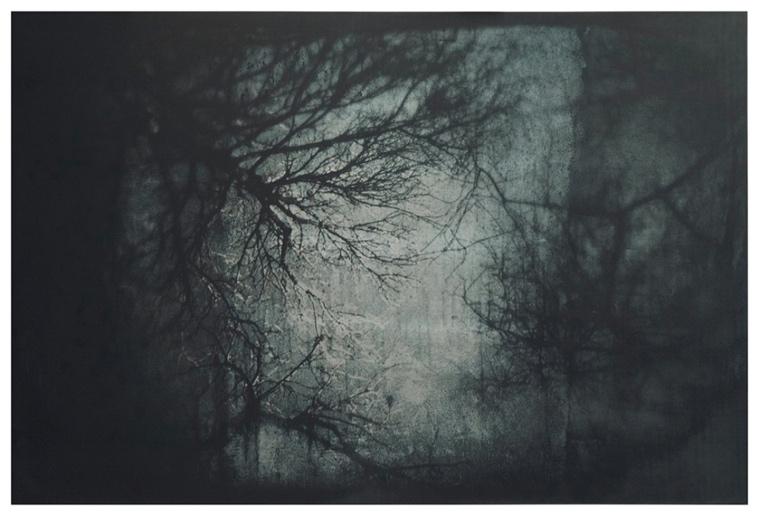
James Turrell, Winter Aqua Oscura, 2015, polymer gravure
etching, paper size: 845 x 1195 m, image size: 730 x 1090 mm
James Turrell’s large-scale polymer print Winter Acqua Oscura (2015) is
striking by being the least subversive in the field. One of a series
with each image recording a different season, the contrast between dark
and light, perception and space lies at the heart of this image, as in
all Turrell’s output. This work reveals a canopy of trees and were made
at Tremenheere using one of Turrell’s two remarkable installations in
the gardens. The process is unconventional but hardly unknown: the lens
as drawing instrument is the basis of photography and from its inception
in the 1840s, nature has been a favoured subject. Turrell’s acqua oscura,
placed in the disused water tank, channels light from outside into the
dark chamber through a lens-like oculus in the roof so that an image of
outside us projected onto a wall inside and underground, materially
registering a natural phenomenon present in sight. Having transferred
the real-time image of the trees, light effectively rewrites on the
underground wall. The print implants it on paper. But just as Mendes
says, Turrell‘s viewpoint is from below – indeed, from below ground –
and perhaps that is its subversive credential.
At the turn of the nineteenth century, in the era of JMW Turner,
landscape was the source of shock and awe. That was the period of the
‘sublime’. Except for the tamest and most cultivated aspects of nature,
the literature of the time described uninhabited terrain with unmixed
horror. That was when man was particularly conscious of his own dignity,
and when the wild forces of nature constituted a threat which he could
not disregard. With the advent of the climate crisis and the spectre of
war on European soil, are today’s artists leading us back to more
critical and inquisitive attitudes to the land that surrounds us?
The Subversive Landscape took place at Tremenheere
Sculpture Gardens, 29 April - 27 May 2023 https://gallery.tremenheere.co.uk/exhibition/the-subversive-landscape/
All images © the artists.
© Martin Holman, 2 May 2023
|








